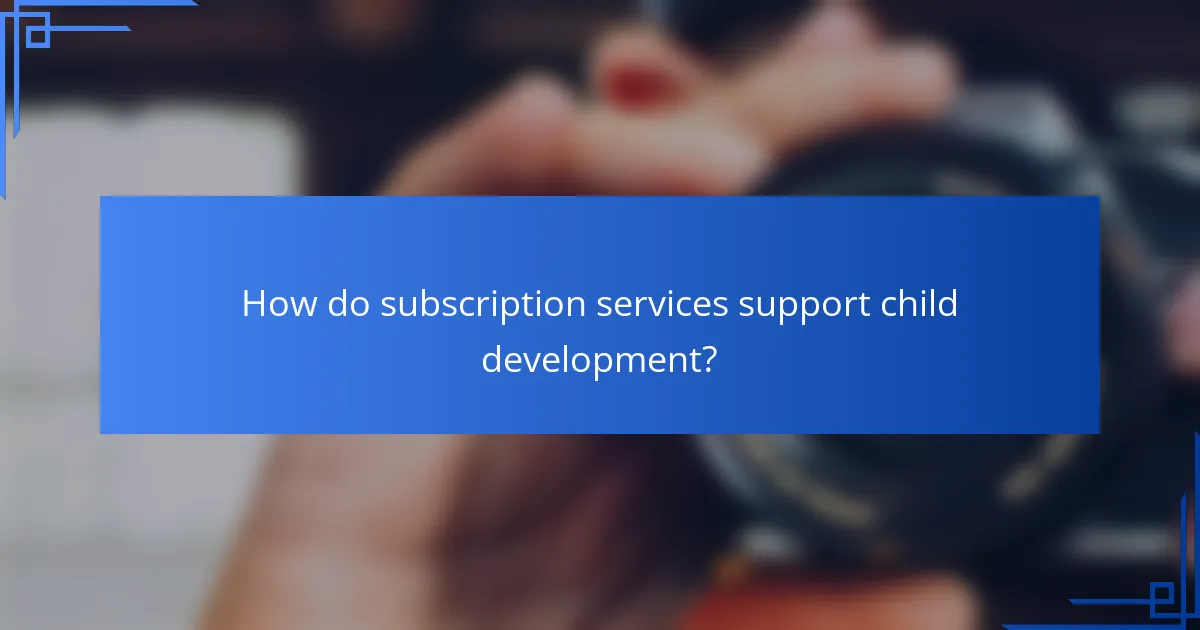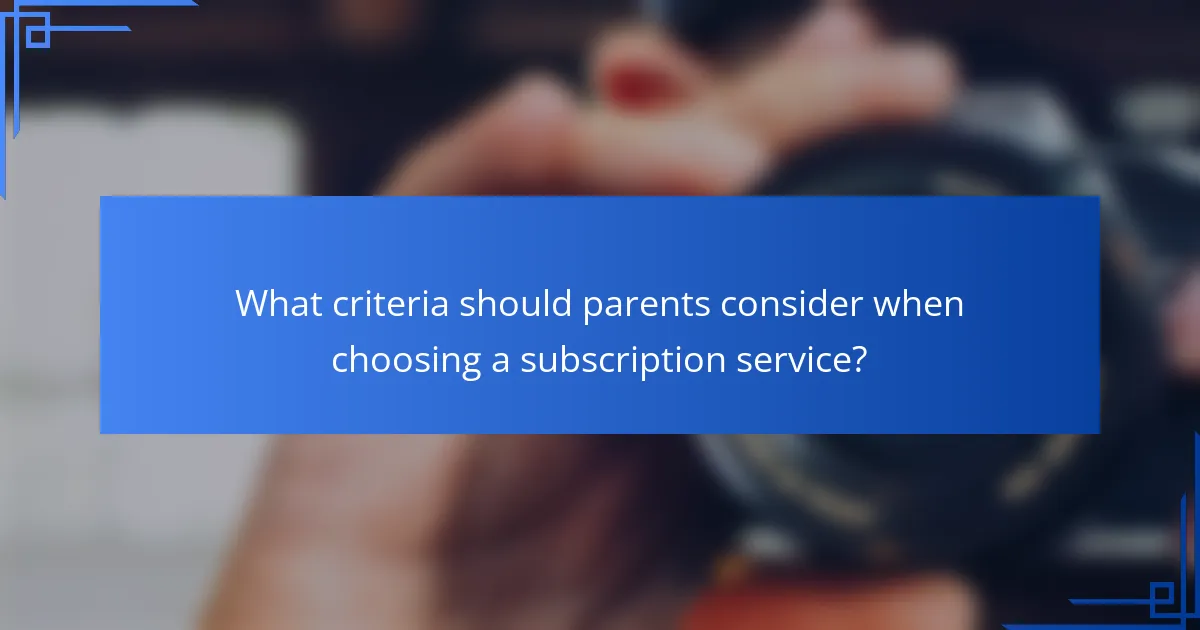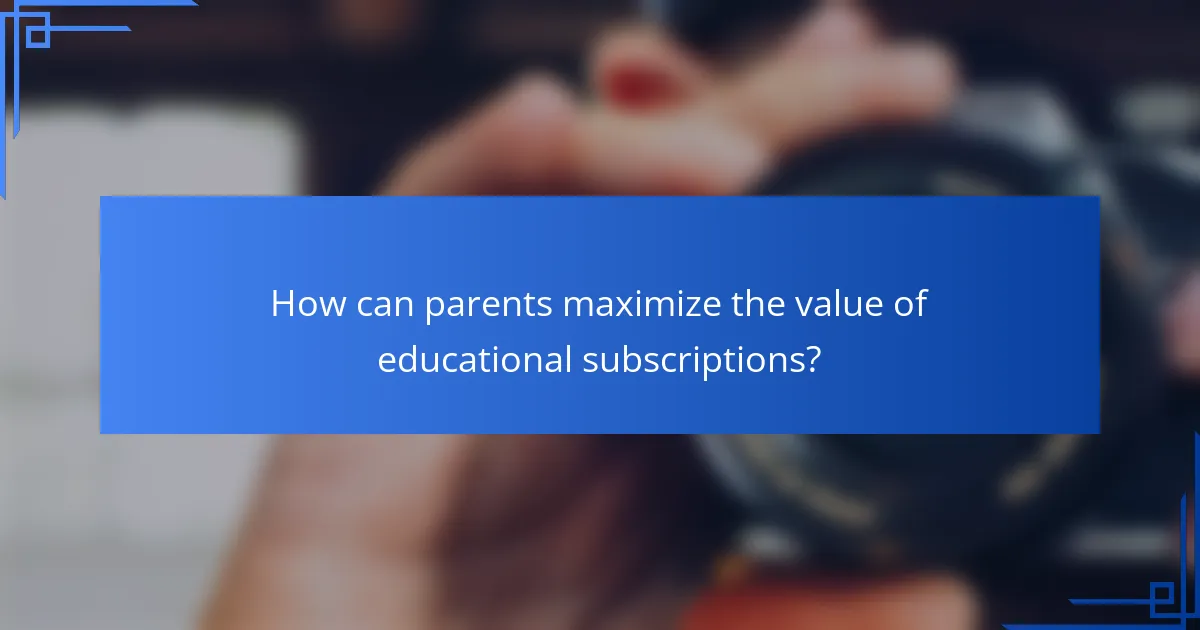Subscription options for educational resources in the US offer a wealth of interactive content designed to support children’s development and learning. These services provide access to lessons and tools that enhance cognitive skills, foster creativity, and promote social-emotional growth, making learning engaging and effective at home.

What subscription options are available for educational resources in the US?
In the US, several subscription options provide educational resources tailored for children’s development and learning. These services offer a range of interactive content, lessons, and tools designed to enhance learning experiences at home.
ABCmouse subscription plans
ABCmouse offers a comprehensive subscription plan aimed at children aged 2 to 8 years. The service features over 10,000 activities across subjects like reading, math, science, and art, designed to engage young learners.
Subscriptions typically cost around $10 to $15 per month, with discounts available for annual plans. Parents can track their child’s progress through detailed reports, making it easier to identify strengths and areas for improvement.
Scholastic Learn at Home membership
Scholastic Learn at Home provides a membership that delivers curated educational content for children from pre-K to grade 9. This service includes daily learning activities, books, and videos that align with grade-level standards.
Membership costs about $5 per month, and it is designed to be flexible, allowing families to choose activities based on their child’s interests and learning pace. The platform encourages reading and critical thinking through engaging materials.
BrainPOP subscription tiers
BrainPOP offers tiered subscription plans suitable for students from elementary to high school. Each tier provides access to animated educational videos, quizzes, and games covering a wide range of subjects.
Prices range from approximately $10 to $20 per month, depending on the features included. Schools often use BrainPOP for classroom learning, but families can benefit from its resources at home as well, making it a versatile choice for educational support.

How do subscription services support child development?
Subscription services play a significant role in child development by providing access to a variety of educational resources and learning tools. These services can enhance cognitive skills, foster creativity, and support social-emotional growth through engaging and interactive content tailored to children’s needs.
Interactive learning tools
Interactive learning tools are designed to engage children actively, making education enjoyable and effective. These tools often include games, quizzes, and hands-on activities that promote critical thinking and problem-solving skills. For instance, platforms may offer math games that adapt to a child’s skill level, ensuring they are both challenged and supported.
When selecting interactive tools, consider those that align with your child’s interests and developmental stage. Look for options that encourage exploration and creativity, such as art apps or science experiments that can be conducted at home. A good rule of thumb is to choose tools that provide instant feedback, helping children learn from their mistakes in real-time.
Personalized learning experiences
Personalized learning experiences tailor educational content to meet the unique needs of each child. Subscription services often use algorithms to assess a child’s progress and adjust the learning path accordingly, ensuring that they receive appropriate challenges and support. This customization can significantly enhance engagement and retention of information.
To maximize the benefits of personalized learning, choose services that offer assessments and track progress over time. Look for features like customizable learning plans or recommendations based on performance. Be cautious of platforms that lack adaptability, as they may not effectively support your child’s growth and development.

What are the benefits of using learning tools for children?
Learning tools for children enhance their educational experience by fostering essential skills and promoting engagement. These resources can significantly contribute to cognitive development and social interaction, which are crucial during formative years.
Enhanced cognitive skills
Learning tools, such as educational apps and interactive games, stimulate children’s cognitive skills by encouraging problem-solving and critical thinking. These tools often incorporate elements of play, making learning enjoyable and effective.
For example, puzzles and logic games can improve memory and reasoning abilities. Parents should look for resources that align with their child’s age and developmental stage, ensuring they are both challenging and accessible.
Improved social interaction
Many learning tools facilitate social interaction by allowing children to collaborate on tasks or compete in friendly challenges. This interaction helps develop communication skills and teamwork, which are vital for personal and academic success.
Group activities, such as coding clubs or science projects, can enhance a child’s ability to work with others. Parents should encourage participation in these activities to foster social skills and build friendships, creating a supportive learning environment.

What criteria should parents consider when choosing a subscription service?
Parents should evaluate several key criteria when selecting a subscription service for educational resources, focusing on content relevance, age appropriateness, and alignment with educational standards. These factors ensure that the materials effectively support their child’s development and learning journey.
Age-appropriate content
Age-appropriate content is crucial for engaging children and promoting effective learning. Parents should look for resources tailored to their child’s developmental stage, which can vary significantly from toddler to pre-teen. Subscription services often categorize their offerings by age groups, making it easier to find suitable materials.
For example, a service may provide interactive games and videos for preschoolers, while offering more complex reading materials and problem-solving activities for older children. Always check the recommended age range before subscribing to ensure the content matches your child’s needs.
Educational alignment with curriculum
Ensuring that a subscription service aligns with educational curricula can enhance its effectiveness in supporting learning objectives. Many services are designed to complement school subjects, such as math, science, and language arts, which can reinforce what children learn in the classroom.
Parents should consider whether the service adheres to local educational standards or frameworks, such as the Common Core in the United States or the National Curriculum in the UK. This alignment helps ensure that the skills and knowledge gained through the subscription are relevant and beneficial for academic success.

How do subscription prices compare for educational resources?
Subscription prices for educational resources can vary significantly based on the type of service, duration, and features offered. Typically, monthly plans are more flexible but can be more expensive over time compared to annual subscriptions, which often provide better value.
Monthly vs annual pricing
Monthly subscriptions usually range from around $10 to $30 per month, depending on the platform and resources included. In contrast, annual subscriptions often offer a discount, bringing the total cost down to approximately $100 to $250 per year.
When considering which option to choose, think about your usage frequency. If you plan to use the resources consistently, an annual plan may save you money in the long run. However, if you’re unsure about your commitment, starting with a monthly subscription allows for flexibility.
Discounts for families
Many educational resource providers offer family plans that can significantly reduce costs. These plans typically allow multiple users under one subscription, with discounts ranging from 10% to 30% off the standard rates.
When looking for family discounts, check if the service allows sharing among siblings or parents, as this can enhance the value. Additionally, some platforms may provide promotional codes or seasonal discounts, so keep an eye out for those opportunities to save further.

What proof exists of the effectiveness of these resources?
Evidence supporting the effectiveness of educational resources for child development and learning tools includes various research studies and user testimonials. These resources are designed to enhance learning outcomes and provide practical benefits for children’s cognitive and emotional growth.
Research studies on learning outcomes
Numerous research studies indicate that structured educational resources can significantly improve learning outcomes in children. For instance, programs that incorporate interactive learning tools often show a marked increase in engagement and retention of information, with improvements typically ranging from 20% to 50% in test scores.
Additionally, longitudinal studies have demonstrated that children who consistently use educational resources tend to develop better problem-solving skills and critical thinking abilities. These studies often emphasize the importance of early exposure to such tools, particularly during formative years.
User testimonials and reviews
User testimonials provide compelling evidence of the effectiveness of educational resources. Parents frequently report noticeable improvements in their children’s enthusiasm for learning and academic performance after using specific tools. Many reviews highlight how these resources make learning enjoyable and accessible.
Moreover, platforms that aggregate user feedback often show high satisfaction ratings, with many parents recommending these resources for their engaging content and ease of use. Common praises include enhanced focus, creativity, and a greater willingness to tackle challenging subjects.

What are the emerging trends in educational subscriptions?
Emerging trends in educational subscriptions focus on enhancing user engagement and personalizing learning experiences. Key developments include gamification techniques and the integration of artificial intelligence, both of which aim to improve child development and learning outcomes.
Gamification in learning
Gamification in learning incorporates game-like elements into educational resources to boost motivation and engagement. This approach often includes rewards, challenges, and interactive activities that make learning more enjoyable for children.
Examples of gamification include point systems, badges for achievements, and leaderboards that encourage friendly competition. These elements can significantly enhance a child’s interest in subjects like math or reading, making them more likely to participate actively.
Integration of AI for personalized learning
The integration of AI in educational subscriptions allows for tailored learning experiences based on individual student needs. AI can analyze a child’s performance and adapt content accordingly, ensuring that lessons are neither too easy nor too challenging.
For instance, an AI-driven platform might adjust the difficulty of math problems based on a child’s previous answers, providing additional practice where needed. This personalized approach can lead to better retention and understanding, making it a valuable tool for parents and educators alike.

How can parents maximize the value of educational subscriptions?
Parents can maximize the value of educational subscriptions by actively engaging with the content and utilizing the resources provided. This involves selecting subscriptions that align with their child’s learning style and developmental needs while regularly assessing their effectiveness.
Choosing the Right Subscription Service
Selecting the right educational subscription service is crucial for maximizing its value. Parents should consider their child’s age, interests, and learning preferences when evaluating options. Look for services that offer a variety of content, such as interactive lessons, videos, and printable materials.
Research user reviews and compare features of different services to find the best fit. Many platforms offer free trials, allowing parents to test the service before committing. This can help ensure the subscription meets educational goals and keeps the child engaged.
Setting Goals and Tracking Progress
Establishing clear educational goals is essential for making the most of a subscription. Parents should discuss objectives with their child, such as improving reading skills or mastering math concepts. Regularly tracking progress can help identify areas where the child excels or needs additional support.
Utilize built-in progress tracking tools that many subscription services provide. These tools can offer insights into the child’s learning journey, helping parents adjust their approach as needed. Setting aside dedicated time each week for educational activities can also enhance the learning experience.
Encouraging Active Participation
Active participation is key to maximizing the benefits of educational subscriptions. Encourage children to ask questions, explore topics in depth, and engage with interactive elements of the platform. This fosters a deeper understanding and retention of the material.
Parents can enhance this experience by participating alongside their child, discussing lessons, and applying what they’ve learned in real-life scenarios. This collaborative approach not only reinforces learning but also strengthens the parent-child bond.
Evaluating and Adjusting Subscriptions
Regular evaluation of the educational subscription is important to ensure it continues to meet the child’s needs. Parents should periodically assess whether the content remains engaging and relevant. If a subscription is no longer beneficial, consider switching to a different service that better aligns with the child’s evolving interests.
Keep an eye on any changes in pricing or features, as some services may introduce new content or tools that enhance their value. Staying informed about updates can help parents make the most of their investment in educational resources.
